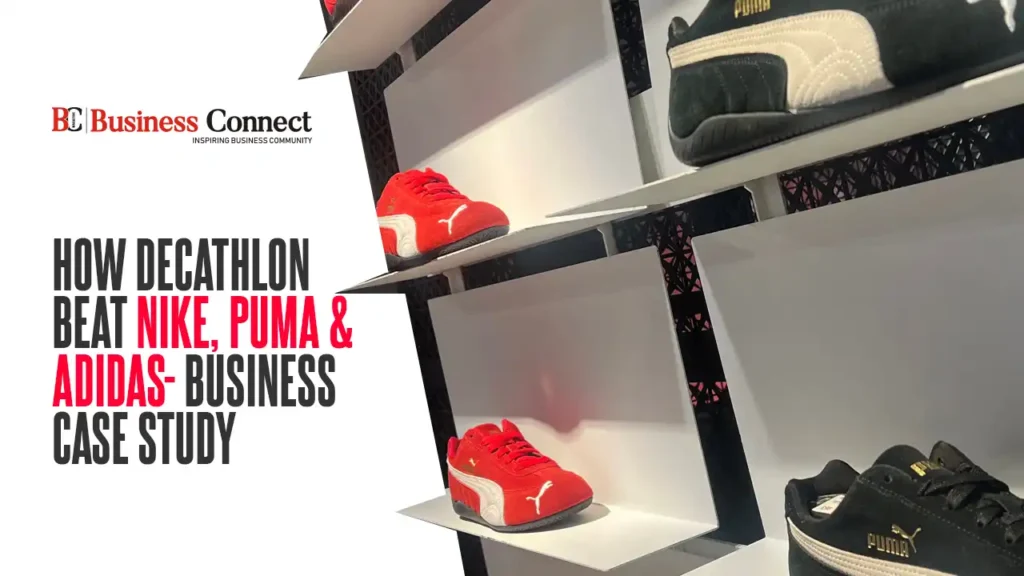The Decathlon Success Story: Beating Global Giants Like Nike and Adidas
Written By Jaya Pathak
Decathlon displaced big sports goods brands by building the world’s largest sporting goods retail footprint and a vertically integrated, private‑brand model that delivers desirable quality at sharper price points unlike other branded rivals. By 2024, Decathlon reached €16.2 billion in net sales with 1,817 outlets across 79 countries, creating a value proposition that challenge Nike, Adidas, and Puma on everyday affordability and accessibility rather than merely being a brand name.
The scale advantage:
Decathlon is the world’s largest sporting goods retailer, operating 1,817 stores across 79 countries by the end of 2024, a footprint that puts its access and distribution beyond specialist mono‑brand peers focused on premium positioning and selective wholesale. The chain expanded by 68 stores during 2024, reinforcing a long‑term thesis that proximity and breadth of assortment are central to winning mass‑market sports retail.
A model built on private brands:
Unlike brand‑led competitors, Decathlon designs, engineers, and sells mostly in‑house “passion brands” (e.g., Quechua, Kipsta, Domyos, Kiprun), allowing tight control of cost, quality, and innovation cycles across the full value chain. Academic and industry analyses consistently identify Decathlon’s private‑label architecture as a strategic lever for differentiation and margin discipline relative to third‑party brand retailing norms.
Vertical integration drives price‑performance:
Decathlon’s vertical model spans R&D, production partnerships, logistics, and owned retail, compressing costs that are otherwise captured by multi‑layered wholesale structures at brand‑centric rivals. The operating logic is explicit: deliver category‑specific performance at accessible prices to grow participation in sport, then monetize across frequency categories through depth of range and store‑led discovery.
Measured growth with financial resilience:
Group net sales reached €16.2 billion in 2024, up 5.2% at constant exchange rates, while digital commerce and connected orders comprised a material share of activity, signalling balanced channel growth rather than subsidy‑driven expansion. The company reported €787 million in net result for 2024, highlighting the earnings capacity of its scale and private‑brand mix even amid cost inflation and competitive pricing pressure.
Competing where incumbents are weakest:
Nike, Adidas, and Puma are iconic product houses whose models rely on premium brand equity, wholesale partnerships, and selectively scaled DTC, which can struggle to match the price‑performance of Decathlon’s private labels across hundreds of practical subcategories. Decathlon’s 2024 strategy explicitly increased investment to make its own brands more competitive versus global icons, further narrowing perceived quality gaps at mid‑price tiers.
Store economics and assortment breadth:
Large‑format stores enable hands‑on trial, in‑aisle guidance, and cross‑category attachment, giving Decathlon an edge in onboarding beginners and value‑seeking families who shop across multiple sports in a single trip. The breadth—from camping and cycling to footwear and team sports—creates repeat purchase loops that mono‑brand stores struggle to replicate at the same ticket and frequency mix.
Digital that supports stores, not supplants them:
Decathlon’s channel mix integrates e‑commerce, connected in‑store orders, and a growing marketplace, with digital representing about a fifth of activity in 2024, used to widen access without eroding the experiential advantages of big‑box retail. This balance avoids over‑reliance on online discounting while preserving store‑led discovery and community engagement that underpin lifetime value.
Brand refresh and competitive posture:
A 2024 brand‑focused transformation elevated key private labels to squarely contend with global performance brands in marketing and design, while maintaining the price‑to‑value edge that built Decathlon’s base. The company’s Olympics tie‑ins and product storytelling reinforced credibility, lifting traffic in core markets without abandoning its mass‑market mission.
Risks and what to watch:
Private‑label portfolios must continually justify performance claims; lapses can quickly erode trust when price is not the only purchase driver. Execution risk also sits in supply chain resilience and in calibrating marketplace participation without diluting the clarity of Decathlon’s own brands.
Why Decathlon “beat” the big three—on retail terms:
Measured by store reach, multi‑sport breadth, and price‑performance at scale, Decathlon has built a retail system that captures customers Nike, Adidas, and Puma often meet only at higher price points or through fragmented wholesale channels. The 2024 performance confirms that value‑led vertical retail can grow earnings while expanding access, which is a different, durable way to win than pure brand premium warfare.
FAQs:
- What is Decathlon current status in today’s market?
Decathlon has 1,817 franchise across 79 countries by 2024, making it the world’s largest company in field of sports.
- How much did Decathlon make by 2024?
Decathlon’s total sales reached €16.2 billion by 2024, making a €787 million net result, with exchange rates being 5.2% constantly and approximately one fifth of sales was from digital orders.
- What is Decathlon’s key plan that gives an edge over other brands?
A vertically integrated, private‑brand model that checks cost, quality, and innovation across different levels in market chain, enabling superior price‑performance versus third‑party brand retailing.
- How does Decathlon compete with big brand rivals such as Nike, Adidas, and Puma?
It invests in in‑house brands and store experience to deliver credible performance at affordable prices, while making a global chain of sports goods that enhances discovery and multi‑sport attachment.
- Why is India important to Decathlon?
The business crossed ₹4,000 crore in FY24 revenue and turned profitable, with further investment planned, reflecting strong demand for value‑led multi‑sport retail.



